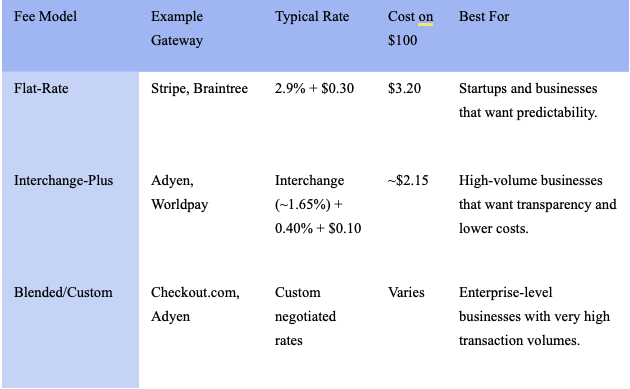
Accepting online payments has become a critical capability for merchants. Without it, customers cannot easily transact with your business when shopping online.
But what is it costing you?
Decisions about payment gateways are too often focused on surface-level factors like brand familiarity or flat transaction rates. Instead, you need to be paying attention to the complexity and variability of payment gateways, and how that can quietly eat into your revenue.
The Nilson Report shows that for every $100 merchants accepted in payments in 2024, $1.57 went towards fees. Merchants also paid more than $38 billion total to accept card payments.
Payments today involve a web of intermediaries that each have their own pricing model and fee structure. What looks like a small percentage per transaction can quickly turn into a substantial cost as your volume increases. While fees are inevitable in any scenario, overpaying is not a non-negotiable.
What is a Payment Gateway?
Payment gateways connect merchants and financial institutions to complete secure transactions.
A payment gateway acts in place of a physical POS system for digital payments. Rather than using a card or tap-to-pay mobile wallet at an in-person terminal, customers enter their payment information into a merchant’s online checkout system. The merchant’s payment gateway of choice is the intermediary that makes communication between the payment system and banks possible.
The extra validation steps that payment gateways add to the payment process make it more likely for a transaction to succeed once it reaches the bank. Online payments lack access to physical verification measures, such as chip reading and tap-to-pay features. Instead, gateways employ identity verification tools that can digitally validate the transaction through other means.
Just like POS systems, payment gateways handle identity verification on behalf of the merchant. A quality gateway will ensure that it helps you meet all relevant regulatory requirements, such as PSD2 and PCI DSS compliance.
What are Considered Payment Gateway Fees?
Setting up a payment gateway and digital payment system is not without its fair share of costs. Just as you might pay credit card processing fees when using a POS terminal, completing transactions online can be subject to a variety of different fees, such as:
- Payment processing fees: Pretty much every payment gateway you come across will charge you payment processing fees (this is a large part of how these providers profit, after all). However, the amount of money you pay per transaction can vary widely depending on which payment gateway provider you choose. The typical equation for a payment processing fee is a set percentage of each transaction, plus a set flat rate added to each transaction. For example, Stripe’s standard payment processing fee for online payments is 2.9% + $0.30.
- Monthly fees: Some providers opt in favor of cheaper payment processing fees per transaction in exchange for a monthly fee. If you are looking for an option that can help you streamline payment costs, many providers offer services at no monthly cost.
- Setup fees: Like monthly costs, the setup costs for a payment gateway depend on the provider. It can also depend on how you have structured your payment system. For example, you could choose to implement an open payments platform from which you can integrate multiple payment gateways easily, which shifts the setup fee from the gateway to the platform.
- Chargeback fees: If and when chargebacks occur, your bank may impose a fee on you to cover the costs of processing the chargeback. The more customers dispute transactions, the higher your risk level becomes, which can lead to banks charging you a higher rate.
You should also consider that payment gateway providers are likely to charge different fees and rates depending on the type of payment method used. If a provider also facilitates alternative payments, like BNPL or direct debits, the processing fee will typically differ from the standard card processing fee.
Another important consideration is that costs may differ if you choose to have a custom payment gateway solution. Custom solutions are a great option if you are dealing with high transaction volumes. They generally offer tailored pricing models that account for the specific features and capabilities you need.

Payment gateway fees comparison
Small differences in fees and costs can add up fast. It’s important to complete a thorough payment gateway fees comparison before committing to a provider. Beyond standard processing fees, you should also dig into what a provider charges for:
- Custom pricing models
- Cross-border transaction fees
- Currency conversion fees
Comparing the difference in fees carefully can help you identify where you can preserve more revenue without heightening your risk for chargebacks or declines.
How Much are These Fees?
Choosing the right payment gateway requires more than a quick glance at advertised rates. Transaction fees and monthly costs can be the tip of the iceberg.
A thorough payment gateway fees comparison should involve evaluating each provider’s pricing model and long-term value to your business. You should compare fees to find the lowest transaction fee payment gateway possible for each payment passing through your system.
Keep the total cost of ownership over time in mind. Some gateways may offer low startup costs but charge higher fees per transaction, which can stack up costs as your volume grows. Alternatively, a provider with a higher monthly fee but lower per-transaction charges could be more cost-effective.
It’s also essential to weigh the cost of fees against the benefits of the features provided. If one provider charges more but includes fraud protection, recurring billing support, or better analytics, those benefits may justify the price difference.
Credit card processing costs also vary based on the pricing structure. Flat-rate processors charge a single fixed rate, while interchange-plus models pass through variable interchange fees with a transparent markup. To make the best choice, compare payment gateway fees with your transaction volume and payment methods in mind. A detailed payment gateway fees comparison helps uncover hidden costs and ensures you’re investing in the right solution for your business.
As you do this research, you may find yourself wanting one payment gateway for a specific type of transaction and a different gateway for another type. A payment gateway may be exceptional for transactions in a specific country, but not globally. Having the ability to leverage different providers based on each payment scenario is a major advantage to seize.
Luckily, we’re living in a time when you no longer have to choose between multiple providers and can, instead, build a payment system capable of multi-provider integrations.
Comparing Gateway Pricing Models: A Practical Example
So far, we’ve covered the basics of payment gateways and the associated fees, but how do these fees play out in the real world? The following comparison of a $100 domestic online transaction demonstrates how costs can vary across three common pricing models:

Note: Interchange fees vary widely based on card type, location, and security measures. This example uses an estimated average.
As you can see, the difference is over a dollar on a single transaction. For a business processing 100,000 transactions per month, that seemingly small difference adds up to over $1,000 in extra fees every month. This is why just looking at the advertised rate is never enough and emphasizes the importance of cost comparisons before committing to one particular pricing model.
Why Do These Fees Exist?
Processing and validating payments takes a lot of effort and technological expertise. It also involves numerous participants, causing funds and information to be transferred across a complex network.
The fees associated with not just payment gateways but the payments industry as a whole are a reflection of the services you use. Providers want to profit, but doing so requires working the cost of technological maintenance and management into their pricing models.
As a business owner, you must become savvy to what is fair pricing and what is not, especially when it comes to the quality and quantity of services available to you. If you choose a payment gateway provider solely because they offer the lowest rates, you may find inadequacies in areas like customer support and security. Likewise, a gateway with the lowest fees may not be as easy to integrate.
Other Types of Fees When Accepting Payments
The payment gateway fees we discussed earlier are far from the only fees you’ll encounter as a merchant accepting online payments. Credit card processing fees are by far the most common and depend on factors generally determined by payment processors and card issuers.
Besides card processing fees, however, other fees to familiarize yourself with include:
- Interchange fees: Merchants are usually responsible for paying interchange fees, a charge used to pay the issuing bank for its services. The issuing bank manages the credit card information and provides the final validation on a transaction.
- Assessment fees: Assessment fees are paid to the card networks to help cover the operating costs necessary for processing payments. These fees are paid by the bank to the card network, and the bank can choose to charge you additional fees to help cover this cost.
- Merchant account fees: If you are working with a payments company that also offers merchant account opening, you may need to pay a regular merchant account fee for the maintenance and management of this account.
- Flat and custom fees: It’s always important to remember that there are custom pricing models available to you through a variety of providers. Flat and custom fees can help you manage costs more effectively when dealing with high transaction volumes or large payment amounts.
How Spreedly Helps You Pay Less Fees
Navigating payment fees can be overwhelming when you’re also trying to enter new markets and integrate better tools into your payment stack.
Spreedly is built to simplify fees through payment orchestration and deep connectivity. We help merchants reduce payment gateway fees by creating a streamlined, open system that integrates multiple gateways. Our open payments platform allows you to connect, manage, and optimize your entire payment ecosystem through a single, unified API.
Orchestration moves fees from a static cost to a dynamic, optimizable part of your revenue strategy.
To illustrate how Spreedly can improve your payment gateway fees for cost efficiency, imagine you have the choice between two distinct gateway solutions:
- Gateway A (Interchange-Plus billing model): Best for domestic US transactions.
- Gateway B (Flat-Rate billing model): Better acceptance rates and pricing for European payment methods.
A payments stack that lacks an orchestration layer forces you to choose one or the other. Comparatively, Spreedly’s Composer solution offers intelligent routing capabilities that allow you to set custom rules and criteria for specific payment scenarios. This service enables your system to automatically route transactions to gateways with the highest chance of success or the lowest fees.
For instance, a $50 Visa purchase from a customer in Ohio can be sent to Gateway A from the example above, costing you just $1.25 in fees. At the same time, if you receive a €50 purchase from a customer in Germany using SOFORT, that transaction can be automatically sent to Gateway B to ensure a high success rate and help you avoid cross-border payment fees.
Need help streamlining your workflows? We’ve got you. Spreedly gives you complete control over your payment strategy so that you can intelligently route and manage payments according to your specific transactional needs, including geographic. Our platform enables and encourages you to integrate multiple payment gateways so that you can minimize fees and maximize performance.
A deeper look into Spreedly’s intelligent routing and multi-provider support
One of the key cost-saving benefits we offer is globally-friendly payment routing. Spreedly intelligently routes transactions according to parameters set by you. You can choose to route through gateways that offer the lowest cost or best acceptance rate for a specific region, leading to better conversion rates and more efficient global operations in international markets.
Our Connect solution provides access to a broad marketplace of leading payment providers and tools. We give you the flexibility necessary to select the right combination of services for your exact payment needs and goals. Mixing and matching payment gateways allows you to achieve lower costs while also maintaining a loyalty-worthy customer experience.
For growing companies, payment needs often change quickly.
Fees and technical constraints can make a once-reliable gateway suddenly inefficient. Our orchestration capabilities let you quickly pivot and reroute transactions to another provider without disruption.
Many merchants also find savings by separating their merchant account from their payment gateway. While bundled services may seem convenient, they often come with higher fees. Our approach supports merchants who want the best of both worlds by having their own merchant accounts and accessing gateways that offer better rates, all from one platform.
Don’t Let Payment Gateway Fees Control Your Revenue
Too many merchants overlook the true impact of payment gateway fees. Treating these fees as static costs rather than variables to be optimized can result in serious missed opportunities for improving the performance and profitability of your payment system.
Increasing your operational flexibility requires you to both understand the complexities of individual gateways and figure out the best plan for keeping the price of fees low. Using the right tools and strategies can help you actively manage the cost of fees and preserve your margins.
It’s not enough to just compare flat rates when choosing your payment gateways. You need to embrace an approach that examines how fee structures change depending on factors like geographic location and payment method. An open payments platform like Spreedly gives you the tools and capabilities you need to build a fully-tailored payment stack that accounts for differing gateway fees.
Our platform empowers you to take charge of your payment ecosystem by routing transactions for optimal cost and performance, integrating multiple providers as you see fit, and reacting quickly to shifting fee structures or technical failures.
With so many ongoing technological advancements in the payments space, you never have to settle for one-size-fits-all solutions. Your approach to payments should be as unique as your business.
At Spreedly, we make sure payment gateway fees become a point of optimization, not a drain on growth.
Get in touch with Spreedly today to get started.
%252520copy%2525202.png)




